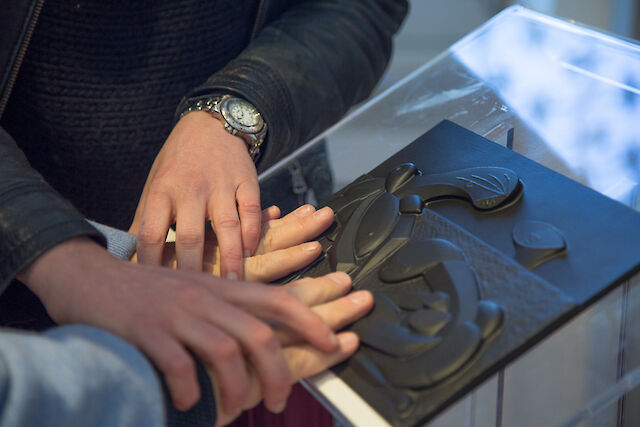
The Peggy Guggenheim Collection relaunches Double Meaning, thanks to the support of Florim. As well as featuring a tour, the program now includes a tactile catalogue for visitors with visual disabilities to enjoy the museum’s rich artistic heritage.
September 15, 2022 – Thanks to the foresight of the Double Meaning: Tactile Tours at the Peggy Guggenheim Collection program, in 2015 the Peggy Guggenheim Collection made its artistic heritage more accessible to the public through tours that encourage learning about art through touch. Over the years, adults and children with visual disabilities have visited the museum and discovered some of its masterpieces through resin and thermoform reproductions, hand-molded by the Center for Educational Material at the Instituto dei Ciechi Milano. During the last three years, the program was forcibly interrupted by the pandemic. But today, thanks to the generous support of Florim—the celebrated Italian ceramics group which has based its growth on sustainable development, and a Guggenheim Intrapresæ member since 2015—Double Meaning is back on track with a novelty. The present format includes a tactile tour led by the program’s curator, Valeria Bottalico, and a workshop led by blind artist Felice Tagliaferri. Now it will also comprise a catalogue of tactile reproductions of works of art in the museum collection alongside their respective captions and descriptions, in Italian and English, both in Braille and in high-legibility print characters. Thus, the museum will offer a tool to support an entirely self-sufficient tour. The kit will be made available upon request. From September 15, Giuseppe Capogrossi’s Surface 236 (1957), Giorgio de Chirico’s The Nostalgia of the Poet (1914), Vasily Kandinsky’s Upward (1929), Fernand Leger’s Men in the City (1919), and René Magritte’s Voice of Space (1931), are on view in the museum alongside their respective tactile reproductions. The tour also includes the tactile exploration of original sculptures by Max Ernst and Alberto Giacometti, following a review of their status of conservation and their tactile legibility. Following the collection’s eventual rehangs, the catalogue for the museum’s blind and visually impaired visitors will integrate the reproductions and information on works of art by other artists, such as Paul Klee, Piet Mondrian, and Pablo Picasso.
As stated by the Director of Peggy Guggenheim Collection, Karol P. B. Vail: “From its inception, Double Meaning established itself as an inclusive, innovative, and experimental accessibility program for blind, visually impaired, and sighted children and adults; a program that strives to create an ever-widening community that is an active participant in the museum’s life, and that therefore aims to promote modern art, as well as the museum’s social and educational role.” The relaunching of Double Meaning was made possible by Florim, the first Italian ceramics company to become a benefit corporation, and the first in the world to be B Corp certified. Through their CEDIT – Ceramiche d’Italia brand, Florim created Hotel Chimera, a ceramic work of art made of 80 unique pieces designed by artist and designer Elena Salistraro, the sale proceedings of which were all used to support the Doppio Senso program. “We believe that art and beauty can be made accessible to everyone, including people with disabilities. We are very proud of participating in this program which affirms the importance of relationships between companies and museums, art, and design,” states the President of Florim, Claudio Lucchese.
Activities will resume in the Fall, following the calendar included below, and are designed to be an inclusive experience for blind, visually impaired, and sighted visitors. They take place once a month and are free until places run out. For information and registration, contact: doppiosenso@guggenheim-venice.it / +39 041 2405401/444.
| 1st meeting | October 22 (for adults) |
| 2nd meeting | November 12/13 (for adults and children) |
| 3rd meeting | December 3 (for adults) |